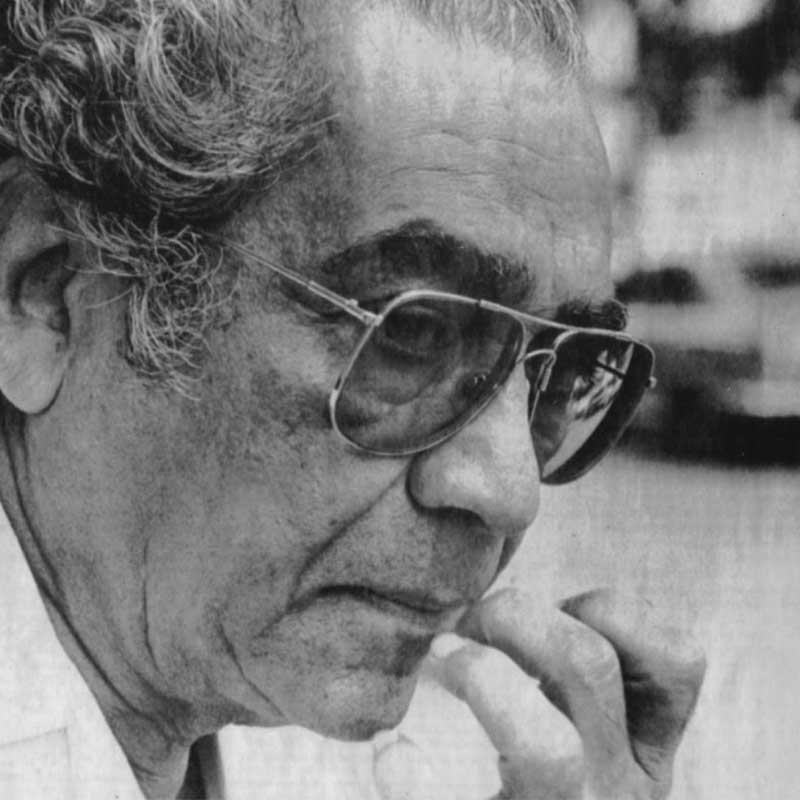
Akbar Padamsee, Works in the Jehangir Nicholson Collection, presents 22 works by the artist that Nicholson put together over 30 years of collecting. The JNAF collection focuses largely on the Progressives and its strength lies in its ability to trace the development of the artist over the various phases of his practice. Akbar Padamsee is no exception with the collection revealing the range of his experimentation with different media, from oil on canvas to watercolours, charcoal drawings, lithographs and digital printmaking. The earliest work in the collection dates back to 1957 with the last work completed in 2000 probably bought by Nicholson just before he passed away.
Born in Mumbai in 1928 Padamsee travelled the world to study art but always returned to the city of his birth. After his art education at Sir J.J. School of Art in Mumbai, Padamsee moved to live and work in France in the year 1951. He was one of the first generation postcolonial Indian artists who sought cosmopolitan freedom in Paris and London during the fifties and sixties. Though widely spoken of as a modernist, Padamsee continues to resist easy categorization.
During a career that explored a wide range of mediums, he managed to remain fiercely experimental and individualistic. His artistic oeuvre is a formal exploration of a few chosen genres- prophets, heads, couples, still-life, grey works, metascapes, mirror -images and tertiaries, across a multitude of media – oil painting, plastic emulsion, water colour, sculpture, printmaking, computer graphics, and photography. His early portraits and landscapes in varied mediums of painting, drawing and etching demonstrate a quasi-spiritual style of working. His oils have been characterised by a deep intensity and luminescence while his drawings exude a serene grace. Renouncing the rich colour palette of his early years, he chose to paint in grey tones between the years 1959 – 1960 stating, “Grey is without prejudice; it does not discriminate between object and space”. These monumental works have been widely recognized for their rich and poetic quality. Like all his works, his foray into computer graphics also shows his distinctive command over the use of space, form and colour. He even made two short abstract films – “Syzygy “and “Events in a Cloud Chamber”, where he animated a set of geometric drawings.
This exhibition celebrates the work of an artist who combines a deeply humanistic approach with a keen aesthetic discipline. The process of creation is one of contemplation and articulation of thoughts and ideas.
Exhibition Catalogue:
Akbar Padamsee: A tribute| Works in the Jehangir Nicholson Collection
Price: 400.00 (Shipping cost not included)
Year of publication: 2020
Size: 27 x 24 cms
Type: Paperback
Pages: 43 pages
ISBN: 978-81-957115-2-9
To purchase: Write to us at connect@jnaf.org

Akbar Padamsee was born in Mumbai in 1928. After his art education at Sir J.J. School of Art in Mumbai, Padamsee went to live and work in France in the year 1951. He was one of the first generation postcolonial Indian artists that sought cosmopolitan freedom in Paris and London during the fifties and sixties. Though widely spoken of as a modernist, Padamsee continues to resist easy categorization.
During his illustrious career, he explored a wide range of mediums, and managed to remain fiercely experimental and individualistic. His artistic oeuvre is a formal exploration of a few chosen genres- prophets, heads, couples, still-life, grey works, metascapes, mirror -images and tertiaries , across a multitude of media – oil painting, plastic emulsion, water colour, sculpture, printmaking, computer graphics, and photography. His early portraits and landscapes in varied mediums of painting, drawing and etching demonstrate a quasi-spiritual style of working. His oils have been characterised by a deep intensity and luminescence while his drawings exude a serene grace. Renouncing the rich colour palette of his early years, he chose to paint in grey tones between the years 1959 – 1960 stating, “Grey is without prejudice; it does not discriminate between object and space”. These monumental works have been widely recognized for their rich and poetic quality. Like all his works, his recent addition of computer graphics also shows his distinctive command over the use of space, form and colour. He even made two short abstract films – “Syzygy “and “Events in a Cloud Chamber”, where he animated a set of geometric drawings.
Since the seventies, his work is seen to alternate between two major genres, luminous metascapes – his signature works, and the human figure which he continues to imbue with an arresting presence. He has a deep and abiding interest in Sanskrit texts, a glimpse of which finds resonance in his statement on the sun-moon metascapes of the mid seventies.
He has exhibited his works in numerous exhibitions in India and abroad. In 2010, he was awarded the Padma Bhushan by the Government of India. Other awards include a gold medal from the Lalit Kala Akademi in 1962, J.D. Rockefeller Foundation fellowship in 1965, Kalidas Samman by the Government of Madhya Pradesh in 1997, Lalit Kala Ratna Puraskar in 2004, the Dayawati Modi Award in 2007, Roopdhar award by Bombay Art Society in 2008 and Kailash Lalit Kala award in 2010.
He passed away in January 2020.